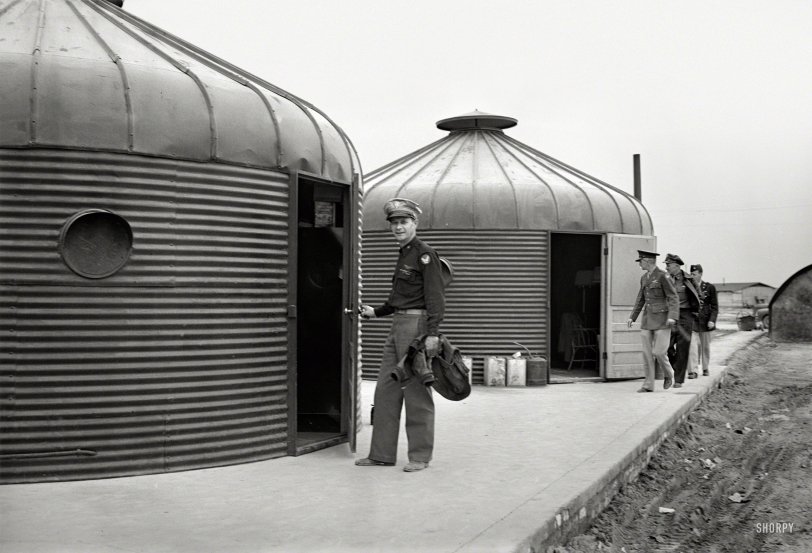


Framed or unframed, desk size to sofa size, printed by us in Arizona and Alabama since 2007. Explore now.
Shorpy is funded by you. Patreon contributors get an ad-free experience.
Learn more.

- Freeze Frame
- Texas Flyer wanted
- Just a Year Too Soon
- WWII -- Replacing men with women at the railroad crossing.
- Yes, Icing
- You kids drive me nuts!
- NOT An Easy Job
- I wonder
- Just add window boxes
- Icing Platform?
- Indiana Harbor Belt abides
- Freezing haze
- Corrections (for those who care)
- C&NW at Nelson
- Fallen Flags
- A dangerous job made worse
- Water Stop
- Passenger trains have right of way over freights?
- Coal
- Never ceases to amaze me.
- Still chuggin' (in model form)
- Great shot
- Westerly Breeze
- For the men, a trapeze
- Tickled
- Sense of loneliness ...
- 2 cents
- Charm City
- What an Outrage
- Brighton Park
Print Emporium
Round House: 1943

Somewhere in North Africa, with Carl Spaatz leading the group on the right.
Circa 1943, another look at the Dymaxion Deployment Units last seen here. In this view, corrugated steel with a glint of brass. Note the book (?) on the shelf. Office of War Information, photographer unknown. View full size.
Uniforms (Again)
Back in the day of the Army Air Corps, there were several uniform combinations. They aren't faded, but denote differences in season. There was a dark winter uniform as well as a lighter colored summer uniform for officers. When the war broke out, they were allowed (I don't know the reason) to "mix" the uniforms. You could wear the dark blouse jacket with the lighter colored trousers together (they called them pinks according to my dad). Consequently, you could see dark or light shirts, dark or light pants and light or dark blouses in almost any combination. Keep in mind, this was the Air Corps who were primarily allowed to do this. Regular ground Army Forces usually kept to the traditional combinations, for the most part. Also, the enlisted uniform was consistently of a more drab brown color that didn't have these variations.
Lack of uniform uniforms
The officer in the foreground and the one in the middle of the other group are wearing their Class B/flight uniforms. The one in front is holding his flight jacket in his hand. Both have removed the stiffening ring from their caps, (something only pilots were allowed to do). It was so they could wear their radio headsets in flight. One step up from fatigues, usually wool blouse*, canvas pants, leather flight jacket.
The General is wearing his Class A uniform, the standard for staff officers. The one in back, probably the General's aide, is wearing his Class A too but with a garrison cap. Garrison caps are handy because you can fold it and put it through the epaulet on your jacket.
If this was in color the uniforms would probably look more alike. The variation is most likely due to age. I imagine General Spaatz' had owned and worn that uniform for years while his aide's in much newer.
*Officially, collared uniform shirts are called blouses, only underwear are called shirts
Carl A. "Tooey" Spaatz
He was promoted to temporary Lieutenant General in March 1943, although it appears he is wearing insignia of a Major General here. When the United States Air Force was formed in 1947 from the Army Air Forces he commanded, General Spaatz became its first Chief of Staff.
Carl Spaatz (pronounced spots) was born Spatz (often mispronounced as spats). He added the second "a" himself in 1937, supposedly at the request of his wife and daughters.
Bins
They do look almost exactly like Butler grain bins. I hope they weren't as hot inside as the bins were in a Kansas summer when I was young.
Why the variety of uniforms?
I have no military experience, and wonder why the four officers in the photo are wearing distinctly different uniforms? I see hats in three styles, pants in three colors, jackets in three styles and colors. No doubt there's a good reason, and thanks if someone will clue me in.
780 Bolts
New York Times, October 10, 1941.A cylindrical dwelling structure of prefabricated corrugated steel, almost identical with the portable grain bins placed by the Department of Agriculture's Ever Normal Granary in farms and towns of the wheat-raising West, was set up yesterday amid the weatherbeaten outdoor art objects of the Museum of Modern Art's sculpture garden. It will be on public view for two months beginning today.
R. Buckminster Fuller, designer of the structure, which is named “The Dymaxion Deployment Unit,” said that it could be produced at the rate of 1,000 a day for the housing of workers around new defense factories, for evacuation dwellings and for army barracks.
Two earlier models, he said, were requisitioned by government departments for experimental study. The present model, consisting of two connected cylindrical structures complete with kitchenette and bath, had previously been exhibited in Washington and Kansas City. It was disassembled three weeks ago in Kansas, shipper here by freight car and put together again with 780 bolts. Mr. Fuller said that the structure, capable of housing a family of six or four times that number of troops, required twelve man-days to put up and four man-days to take down.
























On Shorpy:
Today’s Top 5